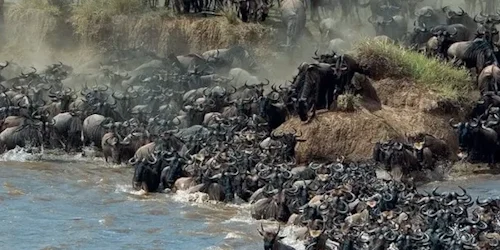Maasai Mara
Maasai Mara , occasionally spelled as Maasai Mara and often simply called ” The Mara” by locals , is a vast National game reserve situated in narok county , kenya. It borders Tanzania’s Serengeti National park , forming part of serengeti ecosystem. The reserve is named after the maasai people , the indigenous inhabitants of the region , who migrated to this area from the Nile basis. The term “Mara” comes from the maasai language meaning “spotted” referring to the landscape characteristic appearance , dotted with the scattered bushy trees
Maasai Mara is a unique wildlife reserve famous for its spectacular natural diversity of wildlife and happens to be a premier kenya safari location in East Africa , offering visitors many reasons to visit the animal paradise . Large numbers of lions, Leopards, Buffalo , Elephants ,Rhinos which are commonly known as the big five and other animals such as wildebeest , giraffe , zebras , Antelopes , gazelles and others are found in the park in their Natural habitat , unconfined and free to roam the vast wilderness stretching on miles on end.
The greater mara ecosystem encompasses areas known as the Maasai Mara National reserve , the mara triangle and several Maasai conservancies where conservancy mean ( protected areas or land management strategy with a strong emphasis on conservation , sustainability and land use practices , and the protection of natural resources such as wildlife and biodiversity) This includes :
Mara North conservancy- which has great wildlife viewing and also promote tourism sustainability
Naboisho conservancy – which has a variety of wildlife
Koiyaki conservancy
lemek conservancy and many more .
The Mara , home of the wildebeest which are dominant inhabitants are estimated in millions where they have a yearly cycle where they migrate. The great migration is often cited as one of the seven Natural wonders of Africa and one of the world’s top ten Natural wonders.
The Migration journey
This typically means the traced movement of the wildebeest from one place to another and their behavior …
- January -March : This is where the calving process happens in the Ndutu region of the serengeti where thousands of calves are born . during this beautiful and stunning transition , this season is crucial for survival because predators are out looking for preys and they target the young calves who are still vulnerable and still dependent on their parents .Also the vast serengeti is full of fresh grass, providing ideal condition for mother wildebeest and their babies. The calving season offers one of the best times to visit .
- April – June : The wildebeest moves North as the dry season starts ,in this season there not concentrated wildebeest as in the calving season and one is able to see long long lines of the wildebeest in accompaniment of zebras, gazelles and predators such as lions who remain active hunting along the migration route. Visitors are able to witness the great migration and other species of animals which is great for a safari experience .
- July – September : In this season , its the Mara crossing where the thousands of wildebeest cross the Mara River here the dramatic crossing as the water predators like the crocodiles , hippos await for their meals. Also this is the peak migration period and its more crowded with tourists who experience the wildebeest determination .
- October – December : The wildebeest begins its journey back to the south after spending several months in the Savannah grassland of the Maasai Mara .
The Maasai Mara is also rich in culture where the Maasai people have maintained their way of life for centuries from traditional clothing to sustainable living.They inhibit northern , central and southern kenya as well as northern Tanzania , have a deep connection to the land.They well known for their tall stature , distinctive shukas and elaborate beadwork.
- Traditional clothing : Their attire which is red often symbolizes strength and bravery which are commonly known as” shukas” are worn by both men and women and add to their jewellery: beaded bangles, earrings, waistbeads , anklets which are important cultural symbols to the Maa people.
- Cultural interaction and tourism : For the visitors who visit Maasai Mara National Reserve and visit the maasai village they learn about the maasai culture , way of life , their music and dances , beadwork and even their homes which are the manyattas and are built by women using organic waste from their animals. The maasai people also play a significant role in wildlife protection , ensuring that tourism and conservation benefit both the environment and the community .
We also have safari – add ons that add up to the great safari experience in the savannah grassland.This includes ;
- Hot Air Balloon safari: This early morning adventure gives you a good view of the Mara savannah and wildlife where you are able to witness herds of animals from above and having a great time.
- Photographic safari – For photographers enthusiasts , they can be able to capture the best shots of the wildlife , birds species and the savannah landscapes.
- Bush breakfast: Have breakfast while enjoying the sunrise over the African savannah in the heart of Nature and the silent sounds of the wilds
- Sundowners :Enjoy your refreshing drink while watching the breathtaking african sunset as a way of relaxing as your day ends.
- Maasai Cultural experience ; Experience the maasai culture their way of life and interreact with the people and how their daily life goes about.
Wildlife and Animals
The reserve is home to variety of large carnivores. Lions sare most dominant , with a large population spread throughout the Mara . spotted hyenas are also common and often compete with lions for food . Leopards can be found on trees , offering them a pace of retreat . Cheetahs often thrive in the open savannah hunting .Various species of antelopes are present in the reserve , including grant’s gazelle , impalas, dik-diks and hartebeests. The plains are also home to the distinct Masai giraffe. The rare roan antelope and nocturnal bat-eared fox, which are seldom found elsewhere in kenya can also be spotted in the Maasai mara.
Recognized as an important bird area by bird life international ,Maasai Mara hosts more than 500 species of birds, many of which are migratory birds like vultures ,marabou stocks and secretary birds can be seen. The area is crucial for threatened species , including martial eagle ( which is endangered) as well as hornbills, crowned cranes, ostriches , long- crested eagles , pygmy falcons and the lilac breasted roller which is Kenya’s National bird .
Hippopotamuses and Nile crocodiles are commonly found in large groups in the Mara river .
The “Big five” lions, leopards ,Elephants , Buffaloes and black rhinoceros can be found year round in the reserve.
The Maasai Mara is also engaged in promoting eco-tourism and tourism sustainability by having conservancies that enable protection of wildlife habitat . the community benefits from the revenue generated from tourism and is shared directly with the local maasai communities by supporting schools , healthcares and local infrastructure . it also helps them preserve their lands and culture for their developments.
Through ecotourism its able to generate employment for the community people which in hand improves the living standards of the community and in return the community helps in sustainability .
Ecotourism in Maasai Mara is also about educating tourists well by raising awareness on the importance of wildlife conservation and the challenges facing the maasai mara ecosystem. And also promote promote eco friendly practices by using solar energies in lodges using eco friendly materials to construct the lodges and respecting local people .
Ecotourism has initiatives like anti -poaching programs to combat poaching of wildlife in conservation areas, by using anti – poaching patrols and tracking the animals movements especially endangered species.Conservation organization like the Mara Elephant project were established to promote peaceful coexistence between human and wildlife .The project highlights Human-wildlife conflict as one of many primary threats to the reserve , particularly as local populations continue to increase.
Final thoughts
Masai Mara stands as a timeless testament to Africa’s wild heart .where nature unfolds in its purest forms.its vast landscape , diverse wildlife ,and the age- gold traditions of the maasai people creates a unique and unforgettable atmosphere. From the thunder of hooves of the great migration to the quite dignity of a lion to the crossings paths with herds of elephants . Every moment in the maasai mara tells a story and feels magical.Mara leaves aq lasting impressions , its as destination that not only captivates the eye but also inspires a deep appreciation for the natural world.

